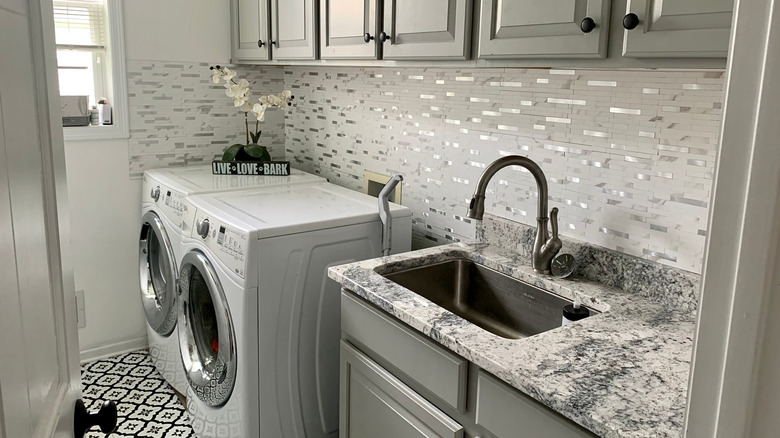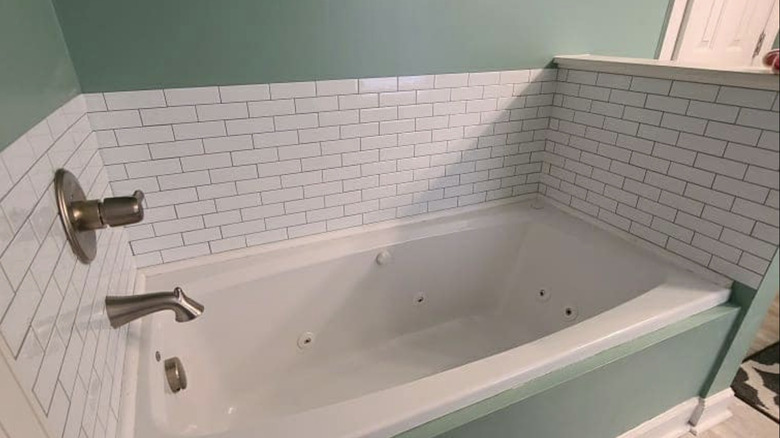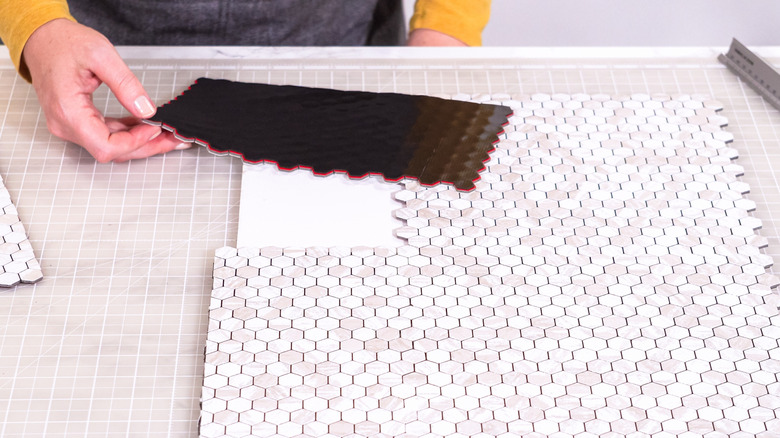Are Aldi's Affordable Peel-And-Stick Tiles Worth Buying? Here's What Reviews Say
If you have a drab interior space, particularly in a bathroom or a kitchen, tile might bring life to the space. But, unfortunately, it takes a bit of skill and a lot of time to install tile. Even if you have experience laying tile, you'll need to purchase or rent a special saw to cut the pieces. If you make a mistake, maybe the grout looks messy or the tiles are unevenly laid, the imperfections will be obvious when you're finished. That's why Aldi offers a peel-and-stick option. You simply press the faux tiles against your wall, like stickers. But are they worth it? The overwhelming customer consensus is: yes!
This option won't look identical to the real thing, but it will save you time and effort. If you make a mistake, these peel-and-stick tiles are a little more forgiving of mistakes than actual tile. You simply peel them off and give it another shot. In theory, this is an attractive concept — a solution that offers a compromise between affordability and an expected aesthetic. However, not all peel-and-stick tiles are equal, and there are a few criteria one can use to judge them. Do they look like real tiles or cheap stickers? Are they easy to use? And perhaps most importantly, do they stay in place, or do they gradually unpeel over time? This is a major point to consider when using stick-on tile, particularly over stoves or in bathrooms, where steam can reduce its adhesion.
Judging Aldi's peel-and-stick tiles by reviewer feedback
A pack of Kirkland Peel-and-Stick Wall Tiles sells for about $10 and contains four pieces, each measuring 12 by 12 inches. This beats out ceramic tile, which goes for between $3 and $40 per square foot. Although these peel-and-stick tiles, available in light blue or white, are currently out of stock, you can keep an eye out for their return. While you're waiting, here's a question to consider: Does this product actually even work? If anyone knows, it's the Aldi Aisle of Shame Community on Facebook, a dedicated online subculture for deal-seeking consumers.
The Facebook group reviewed the product in September 2020 when a member posted a photo of her bathroom after she had applied the tile to the walls. One commenter replied, "It's beautiful. We used similar stuff in our kitchen and it's still going strong several years later." Another person suggested that it would be a good idea to add caulk around the edges to keep moisture from getting in. Other users recommended alternative options sold at Dollar Tree or Lowe's. One user reported using adhesive spray to reinforce her stick-and-peel tiles after they started peeling. A person commented, "If it doesn't stay for 300 years, just glue it, girl. It looks adorable."
Members of the Facebook group have pointed out that, while these tiles are advertised as waterproof, you still have to worry about moisture seeping under them upon application. If you attach these tiles to a surface that isn't already completely dry, they are more likely to peel off. The original poster commented that she prevented this from happening by running a dehumidifier while sticking the tiles to the wall. (via Facebook's ALDI Aisle of Shame Community group)
Our methodology
Typically, when covering products, House Digest uses several different review platforms to determine the popularity of the item. But Aldi does not have a comment section on its website, so the best reviews were available through social media. The Aldi Aisle of Shame Community has over 3.8 million members, which makes it one of the broadest review forums you can find for the product in question.
The post discussing these stick-and-peel tiles had over 6,300 emoji reactions, and all were positive. Of the 659 comments, the overwhelming majority were positive as well. Some commenters offered tips on how to use the product, like reinforcing its watertight seal, but almost no one seemed to have any criticisms. The overwhelming consensus was that the product is affordable and, if used correctly, can enhance an interior space. You can even design your own patterns to maximize the style.


